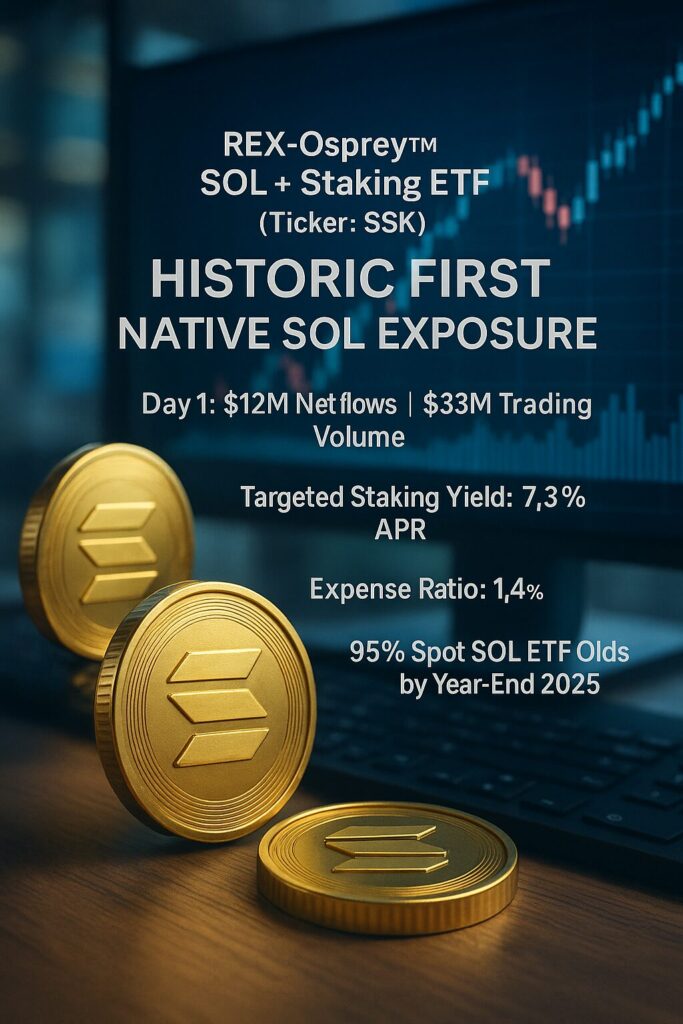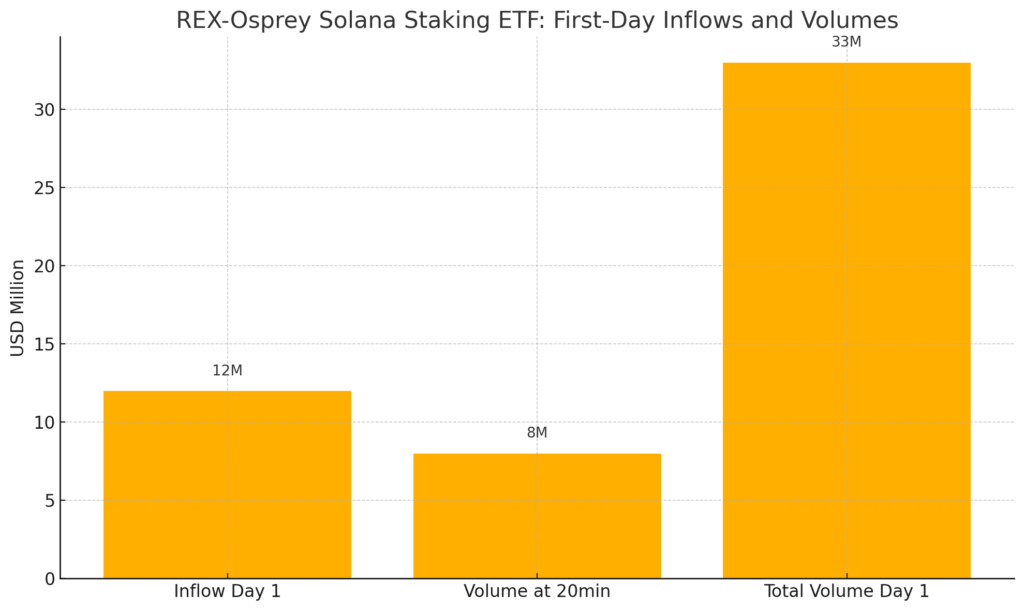
Main Points:
- Historic First: REX-Osprey™ SOL + Staking ETF (ticker: SSK) became the first U.S. ETF to offer native Solana (SOL) exposure with on-chain staking rewards.
- Robust Inflows & Volume: $12 million in net inflows on Day 1; $8 million traded within the first 20 minutes; $33 million total trading volume by close.
- Staking Yield Potential: Targeted staking yield of approximately 7.3% annually, layered on top of price exposure.
- Expense Ratio & Structure: 1.4% fee, with at least 40% of assets held in foreign Solana ETPs to satisfy SEC requirements.
- Spot SOL ETF Odds: Bloomberg analysts now peg the chance of a pure‐play Solana spot ETF at 95% by year-end 2025.
- Broader Altcoin ETF Summer: XRP and Litecoin spot ETFs share similar approval odds, hinting at an “altcoin ETF summer.”
- Regulatory & Institutional Context: SEC’s evolving stance and CME Group’s March futures launch bolster the case for mainstream crypto products.
1. Introduction
On July 2, 2025, the U.S. capital markets witnessed a landmark event: the debut of the REX-Osprey™ SOL + Staking ETF on Cboe BZX under the ticker SSK. This product breaks new ground by allowing investors to gain direct exposure to Solana (SOL)—currently the sixth-largest cryptocurrency by market capitalization—while simultaneously earning staking rewards traditionally accessible only through self-custody on the blockchain. Institutional and retail investors alike have long awaited a regulated vehicle that bridges traditional finance with DeFi mechanisms, and SSK delivers just that.
2. A Milestone in Crypto ETFs: Launch Highlights
The most distinctive feature of SSK is its integration of staking functionality within an ETF wrapper. Unlike existing bitcoin and ether spot ETFs—which simply track on-chain prices—SSK allocates investor capital to actual SOL tokens, which are then staked on the Solana network to earn rewards. This model provides a dual-layer return profile:
- Price Performance: Appreciation (or depreciation) of SOL in the spot market.
- Staking Yield: Ongoing rewards generated by on-chain validation, estimated at 7.3% per annum based on prevailing network rates.
Regulatory approval under the Investment Company Act of 1940 required a compromise: at least 40% of assets are invested in foreign-domiciled Solana ETPs, which mitigates some of the SEC’s concerns about the ETF’s legal classification.
3. Dynamics of First-Day Flows and Trading Volume
Investor appetite was immediately evident. SSK recorded $12 million in net inflows on its first trading day, indicating a strong initial reception among those seeking yield-enhanced crypto access. Trading was brisk from the outset, with $8 million exchanged within the first 20 minutes, culminating in $33 million of total volume by market close.
As shown below, these figures underscore both the depth of interest and the operational capacity of the ETF structure to process substantial orders without significant slippage.
Figure 1. REX-Osprey Solana Staking ETF: First-Day Inflows and Volumes

(Chart displayed above)
4. Staking Mechanics and Yield Potential
Staking Solana involves delegating tokens to network validators in exchange for a share of block rewards. Typically, individual stakers must manage node relationships, track uptime, and navigate slashing risks. SSK abstracts all of this:
- Validator Selection: Professional asset managers choose reputable validators with high performance.
- Automated Delegation: Investor SOL is pooled, staked, and rewards are reinvested automatically.
- Risk Management: Exposure to slashing (penalties for validator misbehavior) is hedged by diversified validator pools.
With network staking yields averaging around 7.3%, SSK offers an attractive counterpoint to traditional fixed-income in a low-rate environment—and an innovative way for investors to “earn” while they hold.
5. Expense Ratio and Competitive Landscape
At 1.4%, SSK’s annual fee sits above many passive equity ETFs but aligns with the complexity of staking operations. For comparison:
- Bitcoin Spot ETFs: ~0.15–0.25%
- Ethereum Spot ETFs: ~0.30–0.40%
- Specialty Crypto Products: 0.75–1.0%
Industry watchers anticipate competitive pressure as larger issuers (e.g., BlackRock, Fidelity) eye similar staking-enabled or pure-play Solana ETFs. Lower-cost versions could emerge, though regulatory approvals remain the gating factor.
6. Future Prospects: Spot SOL ETFs Looming
While SSK pioneers the staking approach, several filings for pure spot Solana ETFs are in SEC review. Bloomberg’s Eric Balchunas and James Seyffart upgraded their approval odds for SOL, XRP, and LTC spot ETFs to 95% by the end of 2025, citing the regulatory precedent set by Ethereum and Bitcoin spot ETFs. Cointelegraph reports that final SEC decisions on these altcoin spot ETFs are expected between October and December 2025.
Additionally, the new CME Solana futures contracts—scheduled for March 17, 2025—will likely satisfy the SEC’s need for regulated price discovery before green-lighting spot ETPs. These futures offer two contract sizes (500 SOL and a “micro” 25-coin contract), broadening institutional engagement.
7. Broader Market Implications: Altcoin ETF Summer
Analysts now speak of an “altcoin ETF summer,” anticipating a wave of new offerings beyond bitcoin and ether. With Solana leading the charge, other protocols such as XRP, Litecoin, Dogecoin, Cardano, and Polkadot also stand on the cusp of ETF inclusion. The increasing probability of approval across multiple altcoins signals:
- Diversified Crypto Allocation: Investors can build multi-asset crypto portfolios via familiar brokerage accounts.
- Institutional Adoption: Pension funds and endowments may incorporate yield-bearing crypto exposure.
- DeFi Integration: Traditional finance and DeFi converge, erasing boundaries between on-chain and off-chain assets.
8. Regulatory Outlook and Institutional Adoption
The SEC’s stance under Chair Gary Gensler has evolved considerably since late 2023. The approval of bitcoin and ether spot ETFs in January 2025 set a powerful precedent. Now, with staking-enabled and altcoin spot ETF applications in play, Washington regulators appear to favor innovation under stringent oversight. Key factors:
- Regulatory Pathway under the 1940 Act: Clarifies fund structures and investor protections.
- Global Competition: European and Canadian markets already host multiple crypto ETFs (including Solana), pressuring U.S. policymakers to keep pace.
- Political Dynamics: A potential 2025–26 shift in administration could further accelerate approvals, as industry voices anticipate a more crypto-friendly SEC leadership.
Institutional players—from hedge funds to wealth managers—are positioning their platforms for altcoin ETF integration, updating trading systems, compliance frameworks, and custody solutions.
9. Conclusion
The inaugural day of SSK trading marks a watershed for crypto finance in the United States. By fusing on-chain staking yields with regulated ETF structures, the REX-Osprey Solana + Staking ETF paves a dual path for price and yield-seeking investors. As approval odds for pure spot SOL ETFs soar to 95%, and as CME-backed futures prepare to launch, 2025 is shaping up as the year altcoin investing comes of age on Wall Street. For those hunting the next frontier in digital assets—new yield vehicles, diversified exposure, and practical blockchain utilities—the SSK launch is both a milestone achieved and a gateway to broader market transformation.

